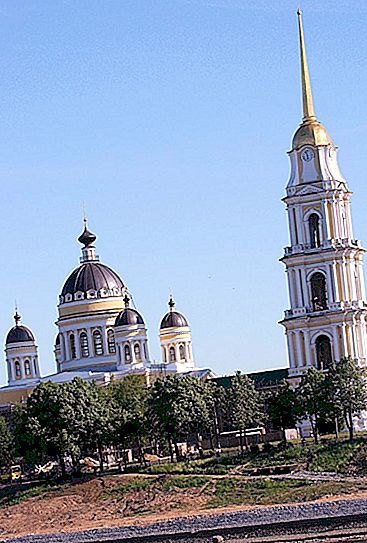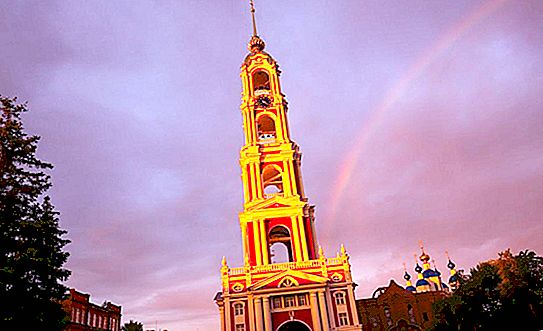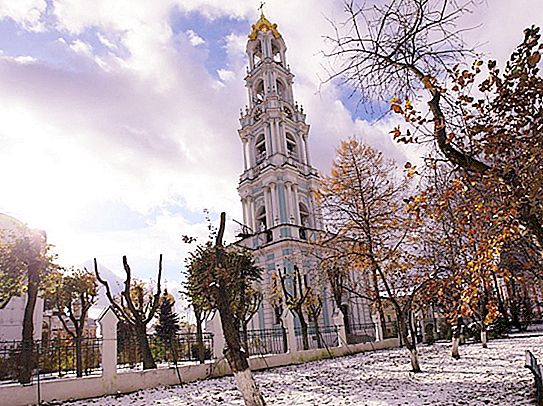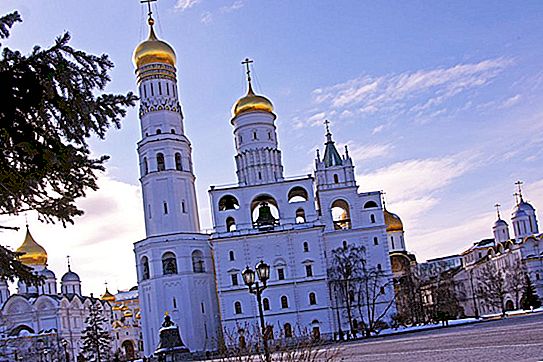The bell tower is a special part of any temple. It is a tower on which one or more bells are installed. As a rule, this is part of the church, it is from there that all parishioners are notified of the beginning of church services, funerals, weddings. The highest bell towers in Russia have always been the main pride of any parish. In earlier times, it was actively used to warn of a fire or to call for the defense of the city. Belfries were an obligatory attribute of Orthodox churches. Among them there are really high, we will tell about the leaders of this rating in our article.
There is no higher

The highest bell tower in Russia is located in St. Petersburg. It is installed on the temple, built in 1733. The height of the bell tower of the Peter and Paul Cathedral is 122 and a half meters. Until 2012, it was the tallest building in the Northern capital.
The newly built Peter and Paul Fortress was chosen as the place for the cathedral. In 1704, the Peter and Paul Church appeared here, which was consecrated. Already on May 14, the first service was held dedicated to the victory of Sheremetev over the Swedes on Lake Peipsi.
When Peter I decided to build this temple, he sought to make a religious building that would meet modern times. Strengthening the dominant position of the new capital, the emperor intended to create a structure that would be higher than the Menshikov Tower and Ivan the Great Bell Tower. It was to become the most significant building of the new city. And so it happened.
Cathedral building
The construction of the cathedral itself began in 1712. The work was carried out in such a way that the wooden temple all the time remained inside the new building. The project was led by an Italian architect, whose name was Domenico Trezzini. It was he who built the highest bell tower in Russia. When the installation of the spire was started, the Dutch master Harman van Bolos was involved in the work.
Peter I ordered that the construction began precisely from the bell tower. The work was carried out for a long time, there was a constant lack of materials and working hands, the peasants who were involved in the construction regularly escaped. Finding new employees was not easy. As a result, the highest bell tower in Russia was completed in 1720.
Initially, the spire was not covered with sheets of gilded copper, this happened much later. The cathedral was finally completed after the death of Emperor Peter I, in 1733. At that time, the height of the bell tower was only 112 meters.
The history of the bell tower
After the establishment of the diocese in St. Petersburg in 1742 and before the consecration of St. Isaac's Cathedral in 1858, the Peter and Paul Cathedral was a cathedral. Upon completion of these events, he was transferred to the court department.
In 1756 there was a serious fire, after which the religious building had to be restored. In 1776, chimes made by a master from the Netherlands, Oort Krasus, were installed on this bell tower in St. Petersburg.
In 1777, the spire was badly damaged by a storm. Peter Paton took up the restoration of the Peter and Paul Fortress, and Antonio Rinaldi executed a new figure of an angel instead of the lost one. In 1830, this figure had to be repaired once again, this time by roofing master Peter Telushkin, who became famous for having gone upstairs and carried out all the work without collecting scaffolding.
In 1858, the wooden structures that still remained in the spire of the building were replaced with metal ones. Changing the rafters was the main goal of this reconstruction. At the suggestion of the mechanic and engineer Dmitry Zhuravsky, a construction was made in the form of an 8-sided pyramid, connected by rings. He also developed a method for calculating the entire structure. After completing all these works, the height of the building increased by another ten and a half meters, reaching the current value of 122 and a half meters.
This bell tower has 103 bells installed right away. Of these, 31 have been used continuously since 1757. It is noteworthy that there is a carillon, from time to time there are concerts of carillon music.
City view
From the observation deck of the bell tower of the Peter and Paul Cathedral offers a beautiful view of the whole city. Visiting the Peter and Paul Fortress itself is free, but in order to climb to the observation deck, you will have to purchase a ticket. The cost of an adult will be 450 rubles, for a student - 250. But once inside, there is an opportunity to buy a passage to the very top. Each adult will have to pay an additional 150 rubles, and a student - 90.
Please note that if your plans include visiting museums on the territory of the fortress, it would be wise to purchase a comprehensive ticket for 600 rubles. It is valid for two calendar days, allows you to visit the Peter and Paul Cathedral, the Trubetskoy Bastion Prison, the Grand Ducal Tomb, the exposition "History of St. Petersburg-Petrograd. 1703-1918", the museum of astronautics and rocket technology. True, to visit the observation deck of the bell tower of the Peter and Paul Cathedral, you still have to buy an additional ticket.
Four times during the day excursions go up to the bell tower. Groups gather at 11:30, 13:00, 14:30 and 16:00. The guide will have to pay an additional 150 rubles for an adult visitor and 90 for a student.
If you wish, you can climb the stairs to the bell tower on your own. This option has an undeniable advantage: in this case you do not have to hustle on narrow stairs.
If the height of the building is 122 and a half meters, then the observation deck is located at the level of 43 meters. In the bell pedestal, do not miss the three graves that belong to Marya Alekseevna (the sister of Emperor Peter I), as well as the son of the ruler Alexei Petrovich and his wife Princess Charlotte Cristina Sofia.
The visitor will be at the lower level of the bell tower, breaking the erased steps. Here it is worth paying attention to the material from which they are made. This is a natural stone, so it is slippery after several million tourists have walked up the stairs.
Flush with the roof of the cathedral at a height of 16 meters is the museum for the construction of the bell tower itself. It details the three centuries of its existence. For example, in one of the shop windows you can see an exhibit of the model of the cathedral of 1733, as seen by the architect Domenico Trezzini. During the Great Patriotic War, when Leningrad was in a blockade, it was here that the air defense station was located.
The next level is at a height of 24 meters. Here you can finally hear the ringing of bells, and on the wooden beams there is a carillon that accompanies it. It is interesting that the very first carillon appeared here during the life of Peter I, but it has not survived to our time. It was possible to restore it relatively recently, in 2003, when the 300th anniversary of the founding of St. Petersburg was celebrated. The Belgian Royal Carillon School provided substantial assistance in this.
The current carillon is considered one of the largest on the entire European continent. It includes 51 bells, the total mass of which is about 15 tons. And the total weight of the entire tool is 25 tons. The largest of the bells that make up the modern carillon was cast on the personal savings of the Belgian Queen Fabiola. It has a royal crown weighing three tons.
The smallest of the bells weighs only ten kilograms, in diameter it does not exceed 19 centimeters. It is noteworthy that the bells themselves are motionless. In order for the carillon to come into action, a special person controls it from the remote control, to which the languages of all the bells are attached.
Directly above the carillon is the lower belfry, which is more traditional for a classical Orthodox church. It rings the bells as well as in ancient times. For this, ropes are tied to the bell languages. Here the largest bell weighs five tons, in diameter it is more than a meter, and was cast during the reign of Emperor Nicholas II in Gatchina.
At a level of 42 meters, the observation deck is limited in area. It offers a beautiful view of St. Petersburg. Walking slowly through the territory of the observation deck, you can admire the real postcard panoramas of the Northern capital. Of course, for this it is better to choose a time when the weather will be fine, but, as everyone knows, the climate of St. Petersburg is so unpredictable and variable that it is not always possible to guess.
Transfiguration Cathedral

The list of Russian bell towers in height is presented in this article. In second place is the bell tower located in Rybinsk, this is the Yaroslavl region.
The first stone temple appeared here in 1660, it was built in honor of the Transfiguration of the Lord. Previously, two wooden churches stood in its place. By 1811, the cathedral building no longer corresponded to the population in the city, so it was decided to build a new cathedral. The main difficulties arose because it had to be tied to a 5-tier bell tower, the construction of which was completed in Rybinsk in 1804. Therefore, the designers had only two options, and both suggested the destruction of part of the existing buildings.
They could not reach a final decision for about 20 years. The question was where to build the cathedral - the Red Gostiny Dvor or the old cathedral. Part of the merchants advocated the preservation of the ancient temple, as part of the history of the city, the other did not want to lose the courtyard, pursuing, first of all, mercantile interests. In 1838, they decided to nevertheless dismantle the old temple and immediately begin to build a new one.
In 1845, the main construction works were completed, six years later they finished interior design. The cathedral and the bell tower, built even earlier, were connected by a gallery, so a single architectural complex was designed. In 1851, the new cathedral building was solemnly lit.
Soviet authorities closed the cathedral in 1929, and almost all the bells were dropped from the belfry. In the late 30s, a project for a bridge across the Volga appeared, which involved the complete destruction of a religious building, but it was not possible to implement because of the Great Patriotic War.
In the early 60s, the bridge was still built, and the cathedral and the bell tower were not only not demolished, but also restored. In particular, the bell tower spire was again gilded.
In 1996, the bell tower and gallery were transferred to the Russian Orthodox Church. The bell tower has a height of 116 meters, being one of the highest in the country. Among its architectural features are corner cameras, as well as stairs that lead to the tier of ringing. The decoration is made in the classical style with baroque elements. The design used 52 columns, which visually facilitate the construction, creating the effect of a rapid upward movement.
Monastery

Third place in this ranking is occupied by the bell tower of the Kazan Mother of God Monastery, which is located in Tambov. The cathedral itself was built around 1670 in the south of the city. In 1918 it was closed due to the counter-revolutionary rebellion that occurred in Tambov. During the Civil War, a prisoner camp was organized on its territory, interrogations and executions were conducted. Especially many victims were after the Antonovsky peasant uprising.
At that time, the majestic bell tower was destroyed, according to the official version, because of its dilapidation. The revival of the monastery began only in 1922. The multi-tier bell tower that existed here was built in 1848. During the Soviet era, it was demolished, having organized a city school in that place.
In 2009, its construction began. Two years later, a 20-meter spire weighing about four tons was installed on the structure. This was done using a helicopter. Now this bell tower is considered the highest in the Central Federal District. Its height is 107 meters.
Church of Peter and Paul

The bell tower in the Cathedral of Peter and Paul is considered the highest in Russia among those who are not in cities. It is located in the urban village of Porechye-Rybnoe in the Rostov district of the Yaroslavl region. This is a fairly ancient settlement, the first mention of which dates back to the XIV century.
The Cathedral of Peter and Paul is the five-domed three-altered church, which has a tented bell tower. It was built on the gathering of parishioners in 1768, for a long time was the summer parish of the temple. The bells rang in two aisles - Nikolsky and Kazan. During the years of Soviet power, it was closed, it happened in 1938.
The bell tower in Porechye-Rybny has a height of 93.72 meters. In 2007, it was returned to believers and began to rebuild the temple.
Trinity Lavra of St. Sergius

Another high bell tower is located in the suburbs in Sergiev Posad. The height of the bell tower in the Trinity-Sergius Lavra is 88 meters. It was built by 1770. The bell tower in Sergiev Posad is officially considered one of the outstanding monuments of Russian architecture of the XVIII century. It is decorated with white columns with a complex pattern, and at the top there is a fancy golden bowl.
The construction was supervised by Moscow architect Ivan Michurin, who changed the initial design, since it was supposed to make the bell tower much lower. As the work progressed, shortcomings were noted in the project, so the architect Dmitry Ukhtomsky had to refine it. He decided to make the five-tier bell tower. On the gables of the first tier, it was supposed to place portraits of Russian rulers, and in the parapet area there were 32 sculptures that glorified human virtues. However, this part of the project was not implemented; as a result, instead of sculptures, vases were installed on the parapet. When construction was completed, the bell tower became one of the highest buildings in Russia at that time. Its height, along with the cross, was 87.33 meters, which was 6 meters above the Ivan the Great Bell Tower in Moscow.
At the beginning of the 20th century, there were already 42 bells in the belfry, and on the second tier the Tsar Bell was installed, which at that time was the largest in the country. After the October Revolution, most of the bells were destroyed. On the third tier of the bell tower in 1784, a clock with chimes was created, created by the master Ivan Kobylin from Tula. The watch worked without problems until 1905, but after that the leadership of the monastery decided to replace them with new ones. Near the bell tower is an obelisk in memory of the affairs and events that took place in the monastery.
the Red Square

The height of Ivan the Great Bell Tower in Moscow is 81 meters. The construction is located on the Cathedral Square of the Kremlin. It was built back in 1508 according to the project of the Italian architect Bon Fryazin. Until 1815, it was repeatedly rebuilt and expanded.
The architectural ensemble of the bell tower itself consists of a pillar, which is called "Ivan the Great", the Philaret extension and the Assumption belfry. Now there is an existing temple, as well as exhibition halls of museums.
At this point, the church was laid back in 1329 by order of Moscow Prince Ivan Kalita. She was named after the Byzantine theologian John Climacus. In 1505, it was dismantled in order to start building a temple in honor of Ivan the Great.
The building created by Fryazin turned out to be unique right away in a number of ways. It was very strong, at first, the researchers believed that the foundation of the bell tower was comparable in depth to the level of the Moscow River. But then it turned out that the oak piles were driven only 4.3 meters deep, but at the same time they were set one against the other and covered with white stone, which gives them additional strength. It saves them from decay that the piles are constantly in the water, since groundwater in this place has been specially preserved.
Until 1917, services were regularly held in the Church of St. John Climacus. During the armed uprising, part of the historical buildings was shelled, and significant damage was caused to the buildings. Already in 1918, about two thousand people lived on the territory of the Kremlin, among whom was Vladimir Lenin. It is noteworthy that the living quarters were located on the very bell tower of Ivan the Great. True, the church bell ringing after Easter 1918 stopped ringing in these places, a special ban was imposed on this. There is a legend according to which in the 50-60s one of the soldiers tried to break it, after which the bell languages were riveted.
When the Great Patriotic War began, the command post of the Kremlin regiment was located in the Assumption belfry, and a communications center was located inside the Tsar Bell. After the war, they decided to organize a museum, there exhibited works of art stored in the Kremlin funds. Bell ringing resumed in 1992.
Over several historical periods, this building was the most significant in the Russian capital. Since the 16th century, it became the highest in Moscow, retaining this status until 1952 with some interruptions, until a residential building 16 meters high appeared on Kotelnicheskaya Embankment.




